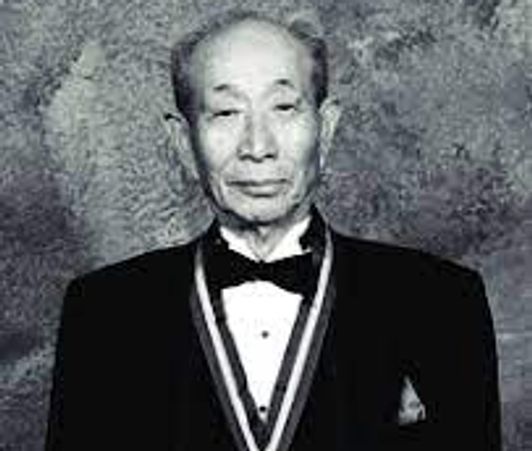Timeline:
How Tyler Prize Laureates have contributed to our understanding of Climate Change and Atmospheric Science

Early 1950s
Roger R. Revelle (1984 laureate) is one of the first scientists to recognize that greenhouse gases produced by humans may dangerously increase average global temperatures.

1952
Willi Dansgaard (1996 laureate) shows that past climates can be studied by measuring the concentration of isotopes trapped in glacial ice. This research would become the backbone of many subsequent studies of prehistoric global climate.

1958
Charles David Keeling develops the Keeling Curve, which shows an increase of atmospheric carbon dioxide over time

Late 1950s
Tungsheng Liu (2002 laureate) begins his research program on loess, a kind of fine dust deposited in the central plains of China. This research would eventually demonstrate that loess provides a reliable record of prehistoric global climate.

1963
Warren M. Washington (2019 laureate) begins his career at The US National Center for Atmospheric Research (NCAR) where he would pioneer computer modeling of climate systems. His models would become the basis for much of modern climate science.

1967
Bert R.J. Bolin (1988 laureate) is integral to the founding of the Global Atmospheric Research Program (GARP), an international organization whose research helped to discover climate change.

Late 1970s
Paul G. Falkowski (2018 laureate) observes that climate strongly influences the distribution and diversity of microbial phytoplankton communities. He describes how these changes impact the flow of nutrients throughout ecosystems.

1970s - 2000s
Lonnie G. Thompson (2005 Laureate) observes patterns of glacial melt, confirming that recent global warming is outside the historical norm.

1972
F. Herbert Bormann and Gene E. Likens discover the detrimental impacts of acid rain on the environment

1975
Wallace S. Broecker, the "prophet of climate change", coins the term "global warming" .
Two years later, in 1977, he proposes the "ocean conveyor belt circulation model", which explains how oceans distribute heat around the globe and influence climate.

Mid 1970s
Veerabhadran Ramanathan (2009 laureate) shows that greenhouse gases other than CO2 contribute to climate change.

1977-1979
Robert M. White (1992 Laureate) shepherds the transition as GARP becomes the World Climate Programme.

1979
Hans Oeschger (1996 Laureate) shows that, during the last glacial period, atmospheric CO2 concentrations were substantially lower than today’s.

Early 1980s
John H. Seinfeld (2012 laureate) and colleague Richard Flagan establish the “Smog Chamber” at CalTech. The first laboratory of its kind, the Smog Chamber and its many successors around the world facilitate basic research on air pollution and climate change.

1982
Paul J. Crutzen (1989 Laureate) publishes landmark research on nuclear winter. Climate models are significantly improved as they account for his work on aerosols and climate.

1983
Lonnie G. Thompson retrieves tropical ice cores from the Quelccaya ice cap in Peru, at an altitude exceeding 5,000 m. These cores help to build a record of prehistoric global climate.

1984
Hans Oeschger is the first scientist to recognize the role that oceans and their currents might play in abrupt climate change.

1986-1993
James J.McCarthy (2018 laureate) chairs the committee setting research priorities for the International Geosphere-Biosphere Programme, at the time a leading organization on the study of climate change.

1987
Bert R.J. Bolin is integral to the founding of the International Geosphere-Biosphere Programme.

1988-1997
Bert R.J. Bolin chairs the International Panel on Climate Change (IPCC), the body that assesses climate science for the United Nations. During his tenure, the IPCC releases its First Assessment Report and Second Assessment Report.

1990s
Wallace S. Broecker developes and popularizes the notion of the “great ocean conveyor,” a system of ocean currents that are understood to facilitate abrupt climate change.

1997
John H. Seinfeld publishes Atmospheric Chemistry and Physics: From Air Pollution to Climate Change, an influential and widely cited textbook.

1999
Michael E Mann (2019 laureate) publishes the landmark “Hockey Stick Paper,” reporting a sharp increase in average global temperatures since the beginning of the industrial revolution.

2001
James J. McCarthy co-chairs the IPCC working group responsible for the IPCC Third Assessment Report.

2004
James J. McCarthy co-authors the Arctic Climate Impact Assessment.

2007
Richard B. Alley (2009 laureate) testifies before the U.S. Senate on the evidence for climate change derived from ice cores.

2007
The IPCC receives the Nobel Peace Prize for the IPCC Third Assessment Report, to which laureates Michael E. Mann and James J. McCarthy contributed.

2008
Sir Andy Haines (2022 laureate) chairs the Lancet Task Force on Climate Change Mitigation and Public Health.

2009-2013
Jane Lubchenco (2015 laureate) administers the National Oceanic and Atmospheric Administration (NOAA), strengthening its role in climate research.

2014
Veerabhadran Ramanathan and coauthors argue that mitigating short-lived climate pollutants such as methane, soot, and hydrofluorocarbons would significantly slow sea level rise due to climate change.

2015
Sir Partha S. Dasgupta (2016 laureate) is lead author on “Climate Change and The Common Good: A Statement of the Problem and The Demand for Transformative Solutions.” This report would provide the scientific basis for Pope Francis’s ‘Laudato Si’ Encyclical on the Environment, in which the Pope promoted climate action.

2019
Andy Haines coauthors “The Imperative for Climate Action to Protect Health”
Copyright © 2024 Contributions to Climate Change by the Tyler Prize - All Rights Reserved.